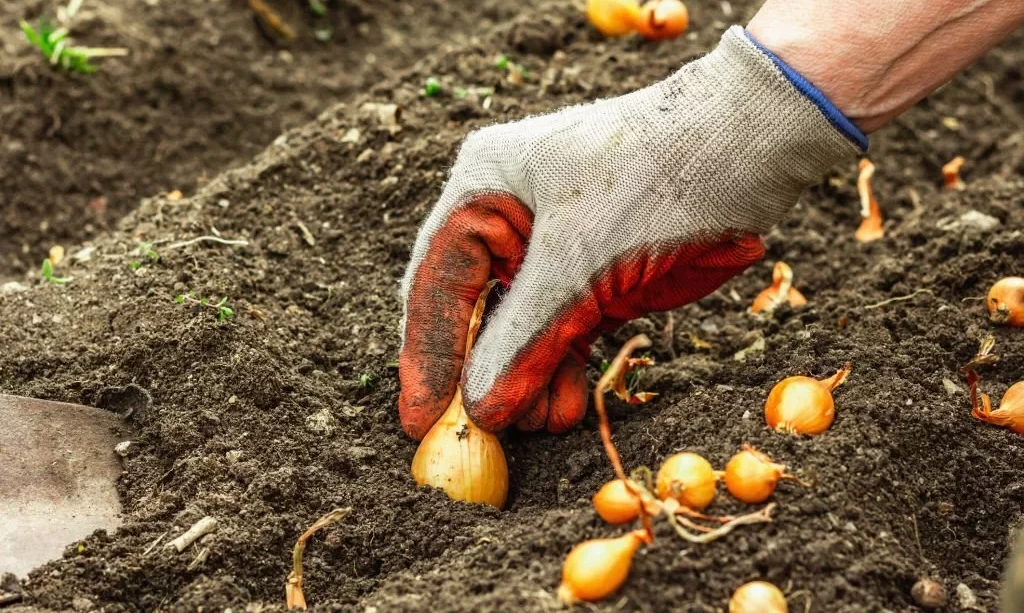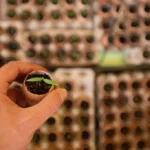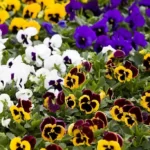When it comes to growing onions, many gardeners think of the traditional spring planting. However, there’s a lesser-known but equally rewarding option: planting onions in the fall. Fall onion planting offers a range of benefits and opportunities for a successful harvest. In this article, we’ll explore the advantages of planting onions in the fall, guide you on choosing the right onion varieties for autumn cultivation, and provide essential tips to ensure a thriving onion crop when the spring season arrives.
- Gardeners love our red, white and yellow onion bulb set collection! Onion sets produce salad onions or full size onions if left to mature.
- Perfect for small home gardens. How to grow planting tip sheet included.
- Contains 8 oz. 50-60 sets Non-GMO onion sets. Grown in USA. Easy to grow.
- Day neutral / long day mix. Grow in the garden, raised bed, kitchen window or container.
- Grow inside for salad greens all year long! Washington and Idaho excluded
The Benefits of Fall Onion Planting
Planting onions in the fall offers a host of advantages that can enhance your gardening experience:
- Early Spring Harvest: One of the primary benefits is the prospect of an early spring onion harvest. Fall-planted onions have a head start in the growing season, allowing you to enjoy fresh, homegrown onions earlier than their spring-planted counterparts.
- Larger Bulb Development: Fall-planted onions tend to form larger bulbs because they have more time to establish strong root systems before winter sets in. This can result in bigger and more flavorful onions when it’s time to harvest.
- Better Cold Tolerance: Onions planted in the fall are more resilient to cold temperatures. They can withstand frost and chilly weather, which can be especially advantageous in regions with mild winters.
Choosing the Right Onion Varieties for Fall
Selecting the appropriate onion varieties is crucial to the success of your fall planting endeavor:
- Shorter Maturity Dates: When choosing onion varieties for fall planting, opt for those with shorter maturity dates. These varieties are better suited for autumn cultivation and are more likely to develop into mature bulbs before winter.
- Consider Storage Needs: Determine whether you want onions for immediate consumption or long-term storage. Some onion varieties are better for fresh eating, while others are ideal for storing throughout the year.
- Adapted Varieties: Look for onion varieties that are well-suited to your specific growing region. Certain varieties may perform better in particular climates, so consider local recommendations or consult with experienced gardeners for guidance.
By carefully selecting onion varieties that match your goals and the fall planting season, you can set the stage for a successful onion harvest that will bring fresh flavors to your culinary creations come springtime.
- VARIETIES Of ONION SEEDS – White Sweet Spanish, Yellow Granex, Tokyo Long White Bunching Green Onion, Yellow Sweet Spanish, Red October, Walla Walla, Red Creole, Texas Early Grano 502
- OUTDOOR GARDEN – Fun onion seeds perfect for your outdoor garden. Seeds can be sown directly into the garden and started indoors (it’s best to start indoors and plant your onion sets)
- TASTY – There’s nothing more satisfying than growing your onions in your homegrown garden
- SUMMER / FALL – Onions are grown in the summer and enjoyed throughout the fall and winter months. Some varieties store well too!
- USA – Our non-GMO, heirloom onion seeds for planting were grown, harvested, and packaged in the USA
Preparing the Garden for Fall Onion Planting
Before you start planting onions in the fall, it’s essential to prepare your garden for optimal growing conditions:
- Soil Preparation: Begin by preparing the soil. Onions thrive in well-draining soil with good fertility. Ensure that your garden bed has loose, loamy soil. If your soil is heavy clay or sandy, consider amending it with organic matter like compost to improve its texture and nutrient content.
- Soil Testing: It’s a good practice to conduct a soil test to assess its pH and nutrient levels. Onions prefer slightly acidic to neutral soil (pH between 6.0 and 7.0). Based on the test results, adjust the soil pH as necessary with lime or sulfur.
- Weed Removal: Clear the planting area of weeds, rocks, and debris. Weeds can compete with onions for nutrients and space, so a weed-free bed is essential for their successful growth.
- Fertilization: Onions have specific nutrient requirements. Before planting, consider applying a balanced fertilizer according to the recommendations from your soil test. Incorporate the fertilizer into the soil to provide essential nutrients for your onion crop.
- Spade To Fork Kits – Our company is family owned and operated right here on our 65 acre farm in rural Oregon. Each Spade To Fork indoor growing system set contains 5 types of Certified USDA Organic Non GMO seeds, including San Marzano Tomato + Early Cherry Tomato + Early Jalapeño + Cilantro (slow bolt) + Green Onion Seeds ; 5 OMRI certified compostable peat pots; 5 OMRI certified rich potting soil discs; 5 custom wood burned plant markers; our beautiful and helpful 26pg growing guide
- Entire Seed Growing Kit Is Certified USDA Organic – Most vegetable salsa garden indoor plant growing system kits only include organic seeds, but their soil and pots of low quality and are not certified. We are strong believers in sustainable, eco friendly, fully organic indoor gardening systems that are safe for our families and women, men, kids and every grower. Our DIY culinary planting system is fully and proudly certified by ODA right here in Oregon
- The Perfect Special Gift – Our home salsa indoor garden kit makes a fun gift for virtually anyone — man or woman, vegetarian or vegans, mom on mothers day, dad on fathers day, best kitchen gifts or housewarming present. Our vegetable seed kits grow perfectly on a windowsill, in an apartment or condominium, in a personal outdoor greenhouse, or in your home window sill, balcony or even countertop
- Bring Your Kitchen To Life! – Every home looks better with fresh vegetables and plants on the countertops. Our decorative family garden kit with seeds for planting vegetables is a unique way to add food to your planters and spice up your mealtime with a little gourmet flavor from your own home gardening kit.
- Plant Growing Kit – It’s not only a great and unique gift, but this organic seeds for planting kit is also a fun everyday activity for the whole family. It doesn’t matter if it’s your first time using seeds for planting indoors, or you’re already a skilled gardener, these vegetable plants will bring taste to your dishes, color to your kitchen and joy to your table.
Planting Onions in the Fall
With your garden bed prepared, it’s time to plant your onions in the fall:
- Spacing: Follow the spacing recommendations for your chosen onion variety. Typically, onions should be spaced 4 to 6 inches apart in rows with 12 to 18 inches between rows.
- Planting Depth: Plant onion sets (small bulbs), transplants, or seeds at the appropriate depth. For sets and transplants, aim for a planting depth of about 1 inch. If you’re sowing seeds, sow them about ¼ inch deep.
- Row Arrangement: Consider whether you want to plant in single rows or raised beds. Raised beds can help with drainage and offer better soil warming, which can be advantageous in cooler fall conditions.
- Watering: After planting, water your onions thoroughly to settle the soil and provide initial moisture to the roots. Ensure consistent soil moisture throughout the growing season, as onions prefer evenly moist but not waterlogged soil.
- The all purpose organic potting soil that fits all your needs; convenience, quality tested organic ingredients and a proven track record of performance
- Offers premium quality at outstanding saving
- This product is made in United States
- Listed by the organic materials review institute for the production of organic food and fiber
- Rich, loamy mix is one of the best for all gardening applications
Caring for Fall-Planted Onions
Proper care is essential to support the growth of fall-planted onions:
- Watering: Maintain consistent soil moisture. Onions need about 1 inch of water per week, either from rainfall or irrigation. Water deeply and regularly, especially during dry spells.
- Mulching: Apply a layer of organic mulch, such as straw or shredded leaves, to help retain soil moisture, suppress weeds, and regulate soil temperature. This is particularly important as temperatures drop in the fall.
- Fertilization: Consider a side-dressing of nitrogen-rich fertilizer in early spring to support bulb development. Follow the recommended rates on the fertilizer label.
- Weed Management: Continue to keep the onion bed free of weeds, which can compete for nutrients and water. Hand weeding or using mulch can help in weed control.
- Pest and Disease Monitoring: Keep an eye out for common onion pests and diseases, such as onion thrips and fungal infections. Early detection and appropriate treatments are essential to prevent issues from escalating.
By following these steps and providing proper care, you can ensure that your fall-planted onions have the best chance of thriving and producing a bountiful harvest in the spring.
- IMPROVE ONION PLANT HEALTH AND QUALITY
- PROVIDES THE NECESSARY AMOUNT OF MACRONUTRIENTS AND MICRONUTRIENTS TO ACCELERATE PLANT GROWTH
- CONTAINS NITROGEN, PHOSPHORUS, POTASSIUM, CALCIUM, MAGNESIUM, SULFUR, BORON, COPPER, MANGANESE, AND ZINC
Protecting Fall Onions from Frost and Cold Weather
As the fall progresses and temperatures drop, it’s crucial to shield your onions from frost and cold weather:
- Frost Protection: Keep an eye on weather forecasts for frost warnings. When frost is expected, cover your onion plants with lightweight frost blankets or row covers. These protective barriers can help retain heat and prevent frost damage.
- Cold Frames: For extra protection, consider using cold frames or low tunnels. These structures create a microclimate that keeps temperatures higher than the surrounding air, shielding your onions from freezing conditions.
- Mulch Insulation: A thick layer of mulch around your onion plants can provide insulation against cold temperatures. This not only helps maintain soil warmth but also prevents soil heaving during freeze-thaw cycles.
- ※Notice: There might be a small amount of defective products mixing in the current inventory. If the fabric you received falls apart within 2-8 weeks, please contact us any time for full refund. Thank you for cooperation !Big Size to cover large area : The size of our plant cover is 10x30ft, the size can cover large areas. You can cut the plant covers freeze protection into different sizes for different use. You can cover it over the plant such as shrub tomato, pepper, pumpkin, and so on.
- ※Lightweight and Breathable MATERIAL Good for protecting Plant: the plant frost cover material is 0.74 oz/sq non-woven polypropylene fabric which is lightweight breathable and durable.The plant blanket frost protection allows sunlight reach the plants, perfect for protecting plant from the damage of freeze or frost.
- ※Wide Application In your Garden Work. The plant row cover not only can work as a barrier against frost , but also can be a great tool for germination and good for rapid seedling growth. By using the fabric plant covers over your plant, you can stat the plant earlier in the spring and extending the growing season of your plants.
- ※How to Use the plant Covers: you can cover the plant covers for freeze over your the plants loosely directly and then secure the plant frost blanket with soil, stones or staples. You can also support the floating row covers with a hoop, make enough room for plants to breath and grow. You could also cut the plant covers into different sizes for different purposes.
- ※SATISFACTION CUSTOMER SERVICE: We don’t just sell plant cover for cold weather, Our helpful and knowledgeable team is available anytime to provide advice and answer any questions to ensure you get the possible results. Have a nice shopping experience on our amazon store.
Harvesting Fall-Planted Onions
When spring arrives, it’s time to reap the rewards of your fall planting efforts:
- Timing: Harvest your fall-planted onions in late spring to early summer when the foliage turns yellow and starts to flop over. This is a sign that the bulbs have reached maturity.
- Harvesting Technique: Gently lift the onions from the soil using a garden fork or your hands. Be careful not to damage the bulbs during this process.
- Curing: Allow the harvested onions to cure for a few days in a well-ventilated, shaded area. This helps them develop a protective dry skin and enhances their storage potential.
Storing Fall-Harvested Onions
Proper storage ensures that your fall-harvested onions stay fresh and flavorful for an extended period:
- Drying: After curing, trim any remaining foliage and roots. Place the onions in a cool, dry, and well-ventilated location for a few weeks to dry thoroughly.
- Storage Conditions: Store cured onions in a cool, dark, and dry place. A basement, pantry, or root cellar with good air circulation is ideal. Avoid storing onions near potatoes, as the gases they release can affect each other’s shelf life.
- Storage Containers: Use mesh bags, wooden crates, or even pantyhose to store onions. These containers allow for proper airflow, preventing moisture buildup that can lead to rot.
Conclusion
Planting onions in the fall offers a unique and rewarding gardening experience, allowing you to enjoy early spring harvests and larger, more robust bulbs. With careful preparation, planting, and protection from frost, you can ensure the success of your fall onion crop.
As you embark on your fall onion planting journey, remember to select suitable varieties, prepare the soil, and provide ongoing care. By following these steps and mastering the art of protecting your onions from chilly weather, you’ll soon be savoring the delicious flavors of your homegrown onions in your favorite dishes.










